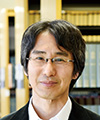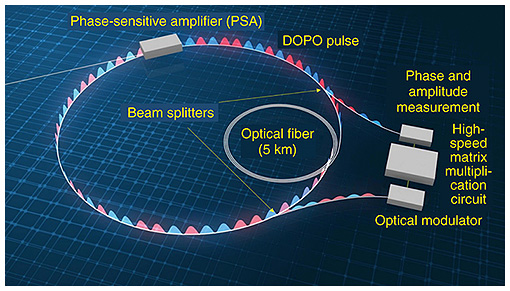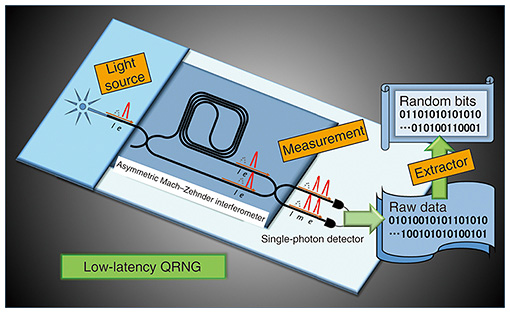 |
|||||||||||
|
|
|||||||||||
|
Front-line Researchers Vol. 20, No. 6, pp. 1–5, June 2022. https://doi.org/10.53829/ntr202206fr1  I Wish to Contribute to the World through Research for the Rest of My LifeAbstractAs the miniaturization of complementary metal-oxide semiconductor electronic circuits that underpin computer technology approaches its limit, the end of Moore’s Law—which suggests that the performance of digital computers increases exponentially over time—has become a reality. Therefore, research on new types of computers that use physical phenomena to efficiently (and at high speed) solve specific problems that digital computers cannot solve easily is being actively carried out. We interviewed Senior Distinguished Researcher Hiroki Takesue, who has published a series of world-leading results in this field of research, about his research achievements and his attitude as a researcher. Keywords: coherent Ising machine, quantum random-number generator, photonic neurons, photonic spiking neurons We demonstrated high-speed solution search of large-scale combinatorial optimization problems using the world’s largest-scale coherent Ising machine—It has been four years since we interviewed in 2018 after you received the Nishina Memorial Prize the previous year. How have your research activities been going since then? One of my current themes, “implementing a large-scale coherent Ising machine (CIM),” has been an ongoing pursuit since 2018. Briefly, an Ising machine is a new type of computer that solves—through physical experiments—the problem of finding the minimum energy state in an Ising model, which is a theoretical model describing how a huge number of microelements called “spins” that can take on either of two values (up or down) interact with each other and behave as a whole. It can be applied, for example, to solve complex combinatorial optimization problems such as finding a one-stroke route that visits many points in the shortest time. A quantum annealer, which is a type of Ising machine and uses superconducting qubits as spins, has been developed. In collaboration with other research institutes under the Impulsing Paradigm Change through Disruptive Technologies (ImPACT) initiated by the Cabinet Office, Government of Japan, we have developed a CIM in 2016, which enables stable and fast calculation of the Ising model using a special laser light that takes on a phase (0 or π) as spins instead of unstable superconducting qubits. We call this CIM LASOLVTM because it solves (“SOLV”) the above-described problem by using a laser (“LA”) (Fig. 1).
In 2019, in collaboration with the National Institute of Informatics (NII), Stanford University, and the Ames Research Center of the National Aeronautics and Space Administration, we used a network of degenerate optical parametric oscillators (DOPOs) to experimentally evaluate the characteristics of a CIM. The results of this experiment revealed that the mechanism of the CIM’s flexible connection among nodes (i.e., a square lattice where spins are arranged) plays an important role in solving complex graph problems at a high probability of success in obtaining correct solutions. In this experiment, we compared the success probabilities achieved with the CIM developed by NTT and that developed by Stanford University as well as a quantum annealer for solving the common combinatorial optimization problem and found that the CIMs outperform the quantum annealer in the case of graphs with high edge density [1]. In 2021, we constructed an ultra-large-scale CIM consisting of 100,000 DOPOs in collaboration with Prof. Kenichi Kawarabayashi and his colleagues from NII [2]. By increasing the scale of the optical system and the measurement-feedback scheme, we developed an ultra-large-scale CIM enabling 100,000 DOPO pulses with up to 10 billion couplings. This CIM can obtain the solution for a 100,000-node combinatorial optimization problem approximately 1000 times faster than by simulated annealing (SA) implemented on a central processing unit at equivalent accuracy. We also confirmed that by changing the operating conditions of the CIM, it is possible to obtain a broader distribution of solutions than that given by SA. Both these results have been published in the American scientific journal Science Advances. —You’ve achieved one world’s first after another. In 2021, we were able to report the following additional results. First, by using a realistic optical device, we developed the world’s-first high-speed quantum random-number generator (QRNG) that achieves a high degree of security [3] (Fig. 2). A QRNG is a device that uses the probabilistic nature of quantum measurement to create true random numbers. Random numbers produced by a QRNG can be made quantum mechanically secure in the sense that if an eavesdropper attempts to eavesdrop in a way that is quantum-mechanically possible, their unpredictability can be guaranteed. Together with the U.S. National Institute of Standards and Technology (NIST), we developed a theoretical method for efficiently guaranteeing random numbers from a small amount of experimental data. Then, by measuring the arrival time of light pulses called “time-bin qubits,” we successfully generated a quantum-mechanically-safe random number composed of 8192 bits every 0.1 seconds. This achievement was published in the British scientific journal Nature Communications.
In collaboration with Kazuyuki Aihara, the deputy director of the International Research Center for Neurointelligence (IRCN) and special professor at the University of Tokyo, and other researchers, we succeeded in using DOPOs for generating artificial photonic neurons that simulate the firing* signals (“spikes”) of neurons [4]. The spiking dynamics of neurons are broadly classified into two classes in accordance with their response to external stimuli. We found that the DOPO neurons that we created have the property that both spiking modes can be freely controlled by a simple operation, namely, adjusting the light intensity of the optical pump to be injected. By controlling the spiking modes, it is possible to adjust the spiking frequency of artificial neurons, which is an important parameter of brain-inspired information processing.
Toward new information processing using the properties of light—It is rare to produce three results per year for basic research, isn’t it? In addition to more than a dozen group members and members of other NTT laboratories, we have been collaborating with NTT Group companies and other companies and organizations, which has enabled us to obtain and publish world’s-first results. Research activities are challenging, and not many companies in the world can take on the challenge of implementing in society the basic research results that were published in academic journals several years prior. We are very fortunate and proud that NTT allows us to take on such challenges. The LASOLV Promotion Project, of which I am a member, is entering a phase in which we are trying to conduct a proof of concept as soon as possible. I want to further clarify the significance of our CIM in terms of basic research and implement it in a manner that people can benefit from it. As a researcher involved in basic research, I believe that such research is the stage at which “seeds” are created, and I understand the importance of creating such seeds. However, it is difficult to implement technology in society by only creating seeds. It is even more difficult in the case of technologies such as a CIM that spans a variety of disciplines, including quantum optics, photonics, computer science, and software. Through my activities in the LASOLV Promotion Project, I realized that by assembling researchers with various abilities and talents in different phases and technical fields, we can produce research results that are both socially and academically significant. —It seems like these research results are going to have a great impact both academically and socially. Although the academic and social significance of the results reported here somewhat overlap, we hope to contribute to the actualization and diversification of information processing using the analog, nonlinear, and quantum properties of light. Our long-term goal is to use DOPO-based spiking neurons as a neuron simulator with plasticity to test hypotheses concerning the function and information processing of the human brain [4]. As I said earlier, we also have succeeded for the first time in the world in generating quantum-mechanically-secure random numbers in real time by using photons, and I believe this achievement is a major step forward in the practical application of QRNGs. Since October 2020, I have also been the head of the Quantum Science and Technology Laboratory of NTT Basic Research Laboratories, and this lab is also actively researching quantum computers. We are often asked about the relevance of a CIM to quantum computing, but the principles and research approaches of the two are completely different. The so-called “quantum computer” is an attempt to create a quantum-computation algorithm with ultimate performance that is theoretically guaranteed then to achieve that performance experimentally. Although physical systems of CIMs have been constructed and empirically and experimentally demonstrated to be used for certain types of computations, the theoretical understanding of those systems is still in the early stages. Quantum computing is a field that is currently attracting a large amount of attention and is expected to progress as a technology of great importance to society. I believe that we can contribute to the diverse development of quantum technology by taking complementary approaches such as researching a CIM in parallel. In our world, we have more unsolved problems than the number of researchers—Could you tell us about your attitude as a researcher and the values that you have maintained? Basically, I have been aiming for the “blue ocean,” a field that has not been much researched by our predecessors. Many things in the world are still not understood, and compared with the number of unknown things, the number of researchers is insufficient. In other words, if you look carefully, you will see many areas of research that have not yet been explored. From that perspective, I believe that it is better to delve into untapped fields than to stay in a field of research that is well established because doing so will expand the opportunity for playing an active role. I think a lot when deciding which theme to pursue; in the end, though, I decide according to whether a theme is interesting to me. To be honest, whether this theme will contribute to society is not the first thing I thought of; instead, I focus on what I intuitively feel is interesting. The significance of a research theme then becomes clear while conducting research on that topic of interest. That was also true in the case of a CIM. I have had a memorable group meeting regarding a CIM. It was a meeting in which we reported on the generation of a large number of DOPO pulses, a basic CIM technique, by using nonlinear optical effects in a 1-km optical fiber ring. It was the first presentation about a CIM at NTT, and I remember that the theoretical researchers in our group relentlessly asked tough questions not only about the experimental results but also about the concept of the CIM. Although I was very excited by the results of an interesting experiment paving a new direction and was confident about the presentation, I was disappointed immediately afterward by the unexpectedly harsh reaction. However, many of the questions and comments I received at that time were highly relevant and have since become a major inspiration for my continued research on the CIM. I was also surprised and encouraged by the fact that, despite seeing this somewhat disastrous presentation, a colleague told me a short time later that he wanted to participate in this research. Come to think of it, perhaps the fact that a CIM was not an established field of study led to such diverse and meaningful responses. —What is your attitude toward research activities in the future? I am now at an age at which I think about how what I am pursuing can have a positive impact on society. When I joined the company, my goal was to first write a paper in English and present it at an international conference; however, as I achieved those goals, I gradually began to think that I would be happy to contribute in some way, such as writing an academic paper, that would have an impact on other researchers in the same field. I don’t know to whom, or at what level, that contribution will be made, but now I’m wondering if my research can help people and society, hopefully directly. Since joining NTT, I have always thought of myself as a young researcher, but now I am 50 years old. Since joining the company, I have been involved in four main themes. Although my current research is very fulfilling and interesting, I feel that it is time to look for a fifth theme so that I can progress further as a researcher. In a recent chat within our group, we learned that Dr. Shun-ichi Amari, who is a leading expert in the field of mathematical neuroscience, is still publishing papers as the first author at 86 years of age, and we talked about how great he is. I’d like to follow his example and continue to be a researcher as long as I can. My goal is to continue to contribute to others and society through my research. As a senior distinguished researcher and the head of the Quantum Science and Technology Laboratory, I also consider it my mission to help junior researchers to be successful. Looking back on my life so far, I had several moments during my research life when I was unsure what to do, but could take a step forward with the help of those around me. I urge all young researchers to find their own “blue ocean,” and I support them in these endeavors. References
■Interviewee profileHiroki Takesue received a B.E., M.E., and Ph.D. in engineering science from Osaka University in 1994, 1996, and 2002. In 1996, he joined NTT Basic Research Laboratories, where he was engaged in research on lightwave frequency synthesis, optical access networks using wavelength division multiplexing, and quantum optics. He is currently pursuing research on communication and computation using quantum optics technologies. He is the recipient of several awards, including the ITU-T Kaleidoscope Conference 2nd Best Paper Award in 2008, The Commendation for Science and Technology by the Minister of Education, Culture, Sports, Science and Technology of Japan (The Young Scientists’ Prize) in 2010, and the Nishina Memorial Prize in 2017. He was a visiting scholar at Stanford University, California, USA, from 2004 to 2005 and guest researcher at the National Institute of Standards and Technology (NIST), Colorado, USA, in 2014. He was selected as an Institute of Electrical and Electronics Engineers (IEEE) Photonics Society Distinguished Lecturer from July 2018 to June 2019. He is a guest professor in the Graduate School of Engineering Science, Osaka University and member of IEEE and the Japan Society of Applied Physics (JSAP). |
|||||||||||










